|
The Secret Of Life?
So... a few complex chemicals make life. But unfortunately living forms need a constant supply of their constituent parts to remain stable (since they all die) to at least live long enough to replicate themselves in slightly variant forms. This means they need a food chain and an energy supply to fuel the lowest forms, since they... the lowest living forms at the bottom of the chain, which have nothing to predate or eat, have to magically make their physical needs from something not living to continue to
exist.
Enter the story... Diatoms, Plankton, Phytoplankton, Algae
We can't eat rocks but we need minerals and inorganic matter to maintain our structures. Diatoms just need rocks (minerals), and sunlight... oh... and Vitamin B too. Living things on planet earth also need oxygen. It doesn't matter if the gas sustaining them is oxygen or carbon dioxide, they all need water and H2O means oxygen has to be present.
|
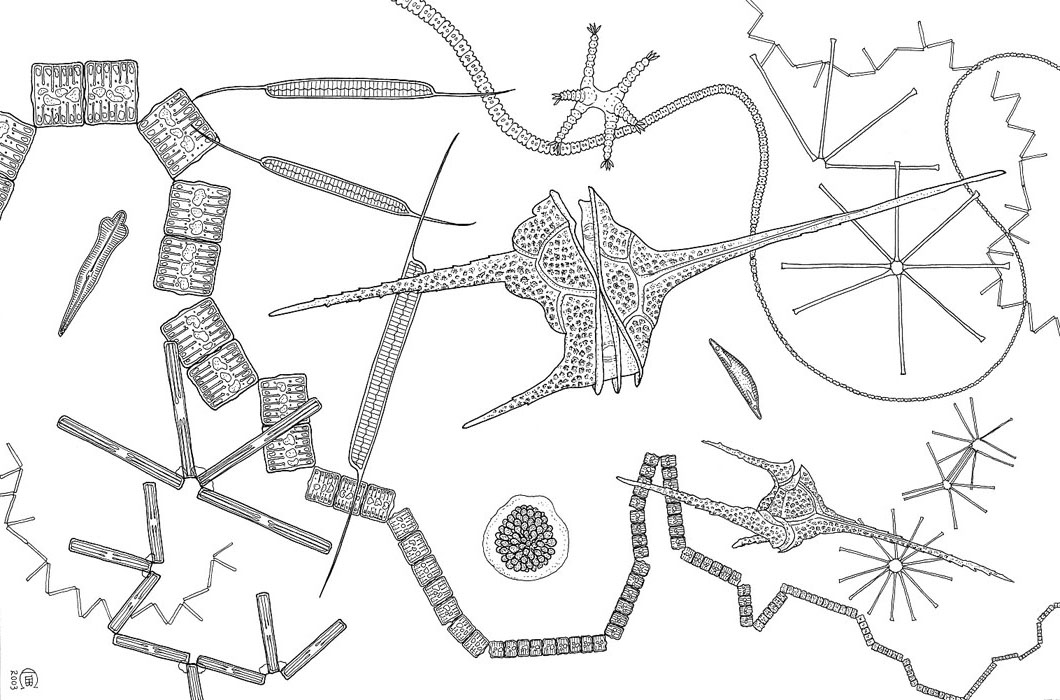
Drawing of various Algae by Christina Brodie, UK
|
Algae perform the extraordinary task of converting direct sunlight into physical matter: chemicals!
Photosynthesis is a process used by plants and other organisms to convert light energy, normally from the sun, into chemical energy that can be used to fuel organisms' activities. Carbohydrates such as sugars,are synthesized from carbon dioxide and water (hence the name photosynthesis. Oxygen is also released, mostly as a waste product. Most plants, most algae, and cyanobacteria perform the process of photosynthesis, and are called photoautotrophs. Photosynthesis maintains atmospheric oxygen levels and
supplies all of the organic compounds and most of the energy necessary for all life on Earth. And of course, these living forms exercising photosynthesis are eaten and thereby maintain the process of re-distributing important nutrients up through the food chain.
So, if I may generalise more for a moment, at least two fundamental and critical processes are required for life as we know it to exist. Not photosynthesis nor the presence of Oxygen. I'm leaving these out along with many, (very many), other interdependencies which also must be maintained in balance. They are not what you think, and they lead to exotic clues that life and our reality may not appear to be what it appears to be at first glance. We'll
get to those in a moment, but first, if you look at some of the microscopic
forms
above you notice they appear to share something in their construction. A kind of similar pattern emerges, complex and compelling! Something they seem to share. What do complex patterns tell us?
Patterns are formed by influences
The closer you look through a microscope, the more things you observe, the more aware you become that similar patterns are emerging from a set of 'influences' which science has deemed the result of mathematical processes - the same underlying behaviours which produce fractals. ref2 ref3
Images on right: first is a photograph of a Sea Urchin. The second is a Fractal Image generated by a computer resolving a set of mathematical formulae and producing a visual interpretation of the result. Any similarities?
Image of Sea Urchin (Wiki creative commons licence). Photographer link.
Fractal deemed to be public domain by google. Found here. |
 |
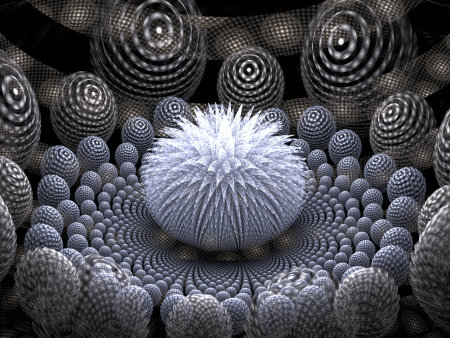 |
You have to think abut this quite carefully. Using a few mathematical formulae and a computer to produce visual geometrical solutions or interpretations of the interactions and relationships between a few variables, we are able to generate shapes and forms similar to the living and non-living structures we see around us; structures formed by invisible influences inherent in the properties of matter itself in our Universe. We also have to think about what we mean by mathematical formulae.
To me, this is maths: 2 + 2=4 or where A = 2 and B = 4, A+B=6. It is way of showing numerically the way two known quantities can be subscribed a total quantity representation - a number. Sometimes, we know a lot about a set of unknowns and their relationship to each other, for example we have say, Ohm's law: I = V/R1 where I= the current, V = voltage, and R=resistance in the circuit. And if we don't know one of the variable's value, because we know the relationship, we can ascertain the unknown quantity. Mathematics remains to be this when quite complex relationships between different variables are involved.
What I believe is that it is important to try and distinguish the essential difference between these two statements: add A and B to make C which is profoundly different from A+B=C.
The first is an instruction. The latter an observation! Computer code is a set of instructions which uses mathematics as part of the process for resolving an outcome as a product of those instructions. Invariably, a computer program has an aim or is exploring ('testing') a way to find a way (a solution) to solve a problem. In all the things one tends to examine within the microscopical world and the Cosmos as a whole, it is clear and transparent to many intelligent minds that the Universe and all
it
contains appears to be the result of iterated code generating new code and all physical entities are driven and manufactured from that code.
Images on right: first (top) is a fractal rendering which produces an image similar to the vegetable Broccoli when an instruction set is applied to use the formulae set and compute an image of a few variables' relationship to each other. The second is a photograph of water vapour (moisture) freezing and fracturing on a glass window pane. The latter process appears to be the result of an instruction set covertly mapped onto the physical material called water and its
relationship to less
contact in its environment with heat energy. The result is a computation which is using mathematics but it is not the result of passive relationships. It is the result of dynamic abeyance to a set of instructions.
We can split hairs about our labels of mathematics and program code, but mathematical formulae not applied remains just that - nothing. To apply it, requires a set of instructions.
By deduction and comparison with our very new tools of computers, logic, computer modeling, and their application (something which Newtonian Scientists, Philosophical Mentors, and Spiritual Thinkers or the past did not possess or utilise in their thinking and work), we can look at our reality completely differently from anyone who ever lived. We have fresh insights.
|


|
fractal brocolli
The fractal shape form of a Romanesco broccoli
Jon Sullivan
(Wiki commons licence)
natural frost patterns
by Schnobby
(Wiki commons licence)
|
We live inside a computer programmed Universe?
You can probably see where I am going with this. I am raising the question that we may be living inside a computer-styled and programmed universe. Which then starts to raise questions about 'intent' and whether or not such an entity could possibly create itself? I am a mere enthusiast microscopist, not formally qualified in any formal topic of education, and so it would seem very audacious for me to suggest such a thing, don't you agree? Ok. Let's not take my word for such an idea, let's go
to someone much respected in the scientific community and see what he has to say.
Enter Stephen Wolfram
From 1992 to 2002, Stephen worked on his controversial book A New Kind of Science, which presents an empirical study of very simple computational systems. Additionally, it argues that for fundamental reasons these types of systems, rather than traditional mathematics, are needed to model and understand complexity in nature. Wolfram's
conclusion is that the universe is digital in its nature, and runs on fundamental laws which can be described as simple programs. He predicts that a realization of this within the scientific communities will have a major and revolutionary influence on physics, chemistry and biology and the majority of the scientific areas in general, which is the reason for the book's title.
This scientist has explored more than most of us put together including quantum physics and Particle Physics. He is cited by over 30,000 publications. I am not saying he says someone or something made our universe, he isn't. I am saying our universe behaves like a computer, and he says that too and before me. What I am saying though is whenever I have built a computer, it doesn't seem likely one could build itself. More.. it seems unthinkable it could built itself through chaotic and random experiment
and by keeping only that which works, and discarding the rest. More-over, any such computer or the parts its made from, need to have an intent to construct itself to begin that task. Where would such an intention originate from?
Back to Fractals, Patterns, and Influences
I mentioned patterns are formed by influences, at least those manifestations we recognise as being patterns. Here are two visual patterns I produced at random in photoshop.
 |
 |
I hope you will agree with me that a few blobs of electronic ink on white electronic paper, which is not repeated within itself or in another image, does not seem to form what we recognise as a pattern. It's almost intuitive, isn't it?
Whatever influenced my hand (my thoughts) on the first image was not the same on my second image. But this is a common aim between the creation of these two images. I aimed not to repeat a similar looking set of blobs and I intended not to create images with any recognisable symmetry. |
|
So... what about the image on the right. Do you see anything obvious there?
What you are observing is a computer animation of a fractal being computed of a Rössler system, a system of three non-linear ordinary differential equations originally studied by Otto Rössler. These differential equations define a continuous-time dynamical system that exhibits chaotic dynamics associated with the fractal properties of the attractor.
An Attractor? Highly exotic, what's that? Fundamentally, it is a bias operating on a system and influencing it in a unique way.
|
|
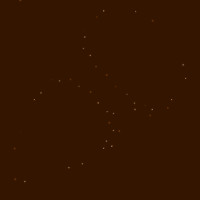
Generated with Fractal Growth Generator for ImageJ; software and animation image by A. Karperien. (wiki creative commons licence).
|
The world of fractals may offer more insights regarding the behaviour of real processes in a real universe. The only method strange attractors use is changing numbers using formulas. This turns out to be very useful in studying nature, where we look at the ways things like population, weather, and chemical reactions change. Scientists found many fractal patterns in these natural changes. In fact, strange attractors like the Rossler
Attractor and the Lorenz Attractor were discovered while studying natural, not mathematical phenomena.
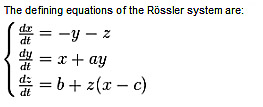
Does our reality have biasing attractors and repellers like the attractors in mathematical systems visualised by computer generated fractals?
Gravity? Dark Matter? Universal Expansion? Life? |
|
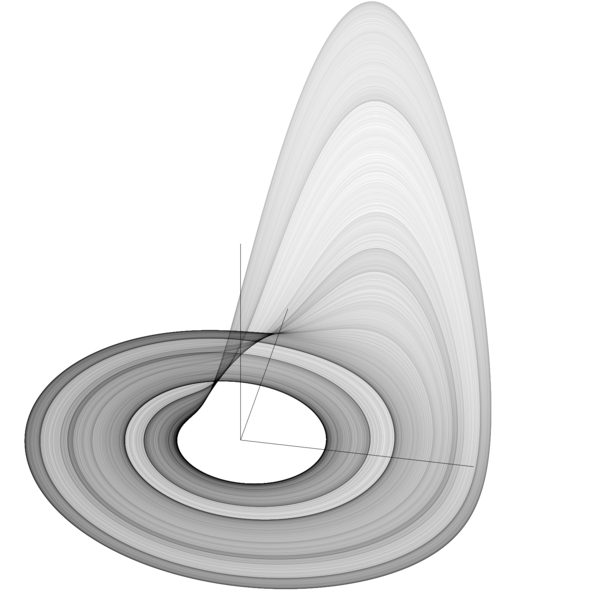
The Rössler Attractor
(wiki creative commons licence)
|
|
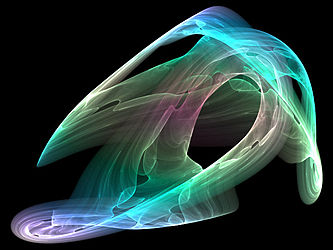
Visual representation of a strange attractor.
Creator: Nicolas Desprez
(wiki creative commons licence)
|
|
An orbit within the attractor follows an outward spiral close to the plane around an unstable fixed point. Once the graph spirals out enough, a second fixed point influences the graph, causing a rise and twist in the -dimension. In the time domain, it becomes apparent that although each variable is oscillating within a fixed range of values, the oscillations are chaotic. This attractor has some similarities to the Lorenz attractor, but is simpler
and has only one manifold.
Otto Rössler designed the Rössler attractor in 1976, but the originally theoretical equations were later found to be useful in modeling equilibrium in chemical reactions.
|
|
An attractor is a set towards which a variable, moving according to the dictates of a dynamical system, evolves over time. That is, points that get close enough to the attractor remain close even if slightly disturbed. The evolving variable may be represented algebraically as an n-dimensional vector. The attractor is a region in n-dimensional space. In physical systems, the n dimensions may be, for example, two or three positional coordinates for each
of one or more physical
entities; in economic systems, they may be separate variables such as the inflation rate and the unemployment rate.
|
| Now... do you recall the rolling dice graphic on my last page? I was trying to indicate that life can only come about the way it has due to a predisposed bias in the chance system... an attractor? The argument is not a case of a Cinderella scenario for a universe which can support life: it is a scenario in which a clear-to-see bias exists to create life! The universe wanted you to
be made! |
|










